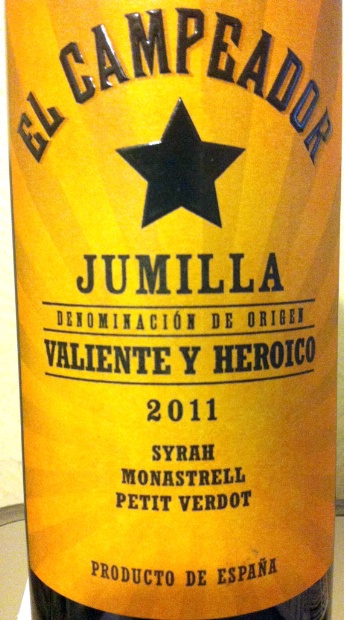
External search
Google (images)
Wine Advocate
Wine Spectator
Burghound
Wine-Searcher
Vintages
2021
2018
2015
2014
2013
2012
2011
2009
From this producer
Show all wines
All tasting notes
|
| Drinking Windows and Values |
| Drinking window: Drink between 2012 and 2014 (based on 6 user opinions) |
| Community Tasting History |
| Community Tasting Notes (average 87.2 pts. and median of 87 pts. in 43 notes) - hiding notes with no text | | | Tasted by Dan & Krista Stockman on 3/8/2014 & rated 87 points: Pretty good. Nice Spanish red, good with food, but certainly nothing spectacular. A solid Thursday night wine. (3313 views) | | | Tasted by Sebdoussin on 9/27/2013: Aroma: lush, summer berry fruits with chocolaty black plum hints
Rich ripe and rounded with plun, rasberry and a touch of pepper (3337 views) | | | Tasted by bobchaplin on 2/8/2013 & rated 88 points: very good, nice spanish red, not too tanic, good fruit (4900 views) | | | Tasted by TampaMark on 1/27/2013 & rated 82 points: Drink now, OK, just didn't do anything for me. (4741 views) | | | Tasted by GrayGhost on 11/13/2012: Good legs with bright cherry color. Good bramble fruit taste imparting a medium tart finish.
(5172 views) | | | Only displaying the 25 most recent notes - click to see all notes for this wine... |
| Syrah BlendThe 2018 is 40% Merlot and 60% Syrah.Spain Vinos de España - Wines of Spain (Instituto Español de Comercio Exterior) | Wikipedia
Wine Map on weinlagen-info
Spain is the third largest wine producing nation in the world, occupying the majority of the Iberian Peninsula with vast diversity in climate, culture, and of course, wine. From inky, dark reds of the [Priorat] to dry, white Finos from Andalusia, Spain can easily boast of elaborating a wide variety of notable styles. Within Spain there are currently 62 demarcated wine regions, of which a handful have gained international recognition: [Rioja], Priorat and [Ribera del Duero]. Yet these regions are only a small sample of the high quality wines Spain produces. Regions such as Cava, Penedes, Somontano, Galicia, Rueda and Jerez are only a few of the numerous regions worthy of exploration throughout Spain. Spain can also lay claim to having the most land under vine in the world, growing up to, by some accounts, 600 indigenous varietals of which Tempranillo is their most well known. Other popular varietals include [Garnacha], Bobal and Monastrell for reds and for whites; the infamous [sic] Palomino Fino grape which is used in the production of sherry wine, Pedro Ximenez in Montilla Morilles, Albarino used in the creation of the bright, effervescent wines of Galicia, and Verdejo in Rueda. - Source: - Catavino.net
Spain is not in the forefront of winemaking for its dessert wines, other than for its sweet wines from Sherry country including the highly revered Olorosos (when sweetened). But apart from Sherry Spain has a range of styles of dessert wines, ranging from the those made from the Pedro Ximenez grape primarily in Jerez and Montilla-Moriles) to luscious, red dessert wines made in the Mediterranean from the Garnacha (Grenache) grape. Some good Moscatels are made in Mallorca, Alicante and Navarre. The northwest corner of Spain, Galicia, with its bitter Atlantic climate, is even making dessert wines, called “Tostadillos” in the village of Ribadivia (similar to France’s “Vin de Paille”). The Canary Islands have made interesting dessert wines for centuries (they are mentioned by Shakespeare, for example) and in recent years the quality of winemaking has been improved and the Canary Islands wines are being better marketed now. The winemaking styles for “Vinos Dulces” are also diverse, from “Late Harvest” (Vendimia Tardía) to “Fortified Wines” (Fermentación Parcial). Based on in-spain.info.MurciaLocated in Southeastern Spain, the "lost" region of Yecla lies to the east of Jumilla and to the west of Alicante. Fortunately, this region was spared much of the wrath of the phylloxera plague, and many ungrafted and extremely old vines remain. The Yecla region’s progressive leader, Bodegas Castaño, has long been an advocate of the Monastrell varietal, also known as Mourvèdre. The varietal is best regarded for its influence on the wines of Châteauneuf-du-Pape where the terroir and climate is not dissimilar to that of Yecla. Both benefit from a very warm, Mediterranean climate with warm days and nights. Jumilla Jumillo DO (Wikipedia)
Appellation Location (Google Maps)
The authorised red grapes are the following:
Monastrell, Tempranillo, (known locally as Cencibel), Garnacha Tintorera, Garnacha, Cabernet Sauvignon, Merlot, Syrah and Petit Verdot (source=wikipedia, Jumilla) |
|




